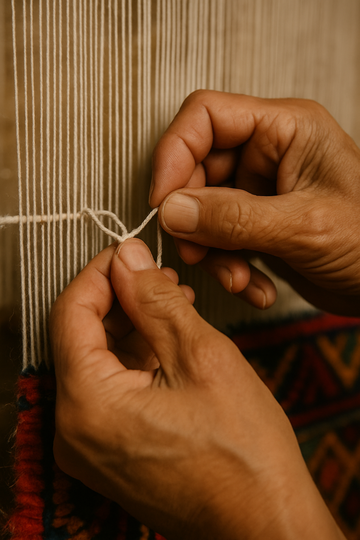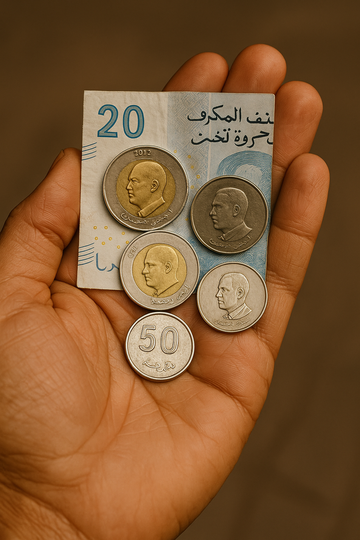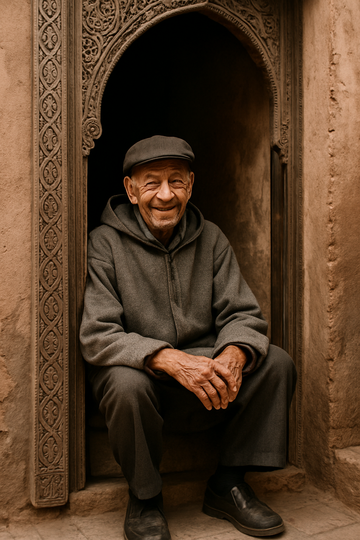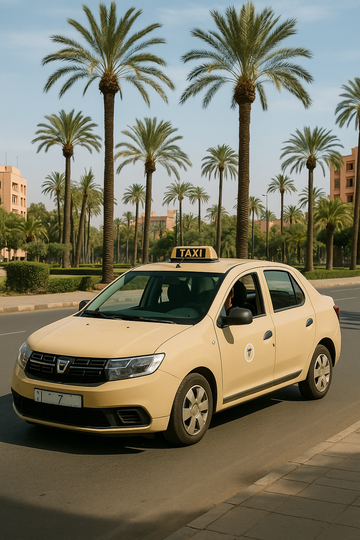To the untrained eye, a Moroccan Berber rug is a beautiful object—a cozy, geometrically patterned textile perfect for adding warmth and style to a room. But to truly appreciate one is to understand that it is a story told in wool and dye, a piece of cultural history created using techniques that have been passed down through countless generations of Amazigh (Berber) women.
These are not just decorative items; they are the result of immense skill, patience, and a deep, ancestral knowledge of the loom. To understand these techniques is to be able to read the language of the rug itself.
Let's take a deep dive into the fundamental techniques that bring a traditional Berber rug to life.

1. The Loom: The Foundation of Creation
The traditional Berber loom is a model of elegant simplicity and functionality. Typically it is a vertical loom, often made of wood, which could be easily disassembled and transported—a crucial feature for the historically nomadic tribes of the Atlas Mountains.
The loom consists of two main beams, between which the vertical threads, known as the warp, are stretched under tension. The warp forms the skeleton of the rug; it is the foundation upon which every knot is tied and every line of weft is passed. The final length of the rug is determined by the length of the warp, and its width by the width of the loom.
Want to see a traditional loom in action? Join us for an authentic rug-making workshop in Marrakech.
2. The Wool: The Soul of the Rug
The soul of an authentic Berber rug comes from its primary material: the wool from the sheep of the High Atlas mountains. This wool is prized for its durability, its high lanolin content (which makes it soft and stain-resistant), and its rich, creamy color.
Before it can be used, the raw wool goes through a painstaking process:
-
Cleaning: The wool is washed, often in a local river, to remove dirt and impurities.
-
Carding: It is then "carded" or combed with large, nail-studded paddles to align all the fibers in the same direction.
-
Spinning: Finally, the carded wool is meticulously hand-spun using a simple wooden spindle (izdi) to twist the fibers into strong, consistent yarn ready for dyeing and weaving.

3. The Knot: The Language of the Rug
This is the most critical and time-consuming part of creating a pile rug. While different cultures use different knots, Moroccan Berber rugs are famous for their use of the Symmetrical Knot, also known as the Ghiordes knot or Turkish knot.
Here’s how it works: a short piece of yarn is passed over two adjacent warp threads and then pulled through from between them, creating a secure knot. The two ends of the knot stick out to form the plush "pile" of the rug.
This technique, where each knot is individually and securely tied, is what makes Berber rugs so incredibly durable and long-lasting. A single rug can contain tens of thousands, or even hundreds of thousands, of these hand-tied knots.
Curious to try it yourself? Book a workshop or learn with our at-home kit.
4. The Weft & Flatweave: The Structural Story
The knots are not the only part of the weave. In between every single row of knots, the weaver passes a thread of yarn, called the weft, horizontally through the warp threads. They pass it over one warp thread and under the next, alternating with each pass.
This weft thread is then tightly beaten down against the row of knots using a heavy comb-like tool called a tazekka. This crucial step locks the knots in place and creates the tight, strong structure of the rug.
Sometimes, the weaver will create entire sections using only this weft technique, without any knots. This creates a flat, non-plush area known as a kilim weave. You often see this at the ends of a rug, creating a beautiful textural contrast.
5. The Symbols: Weaving a Narrative
It is through the combination of these techniques—the patient tying of thousands of symmetrical knots and the structural passing of the weft—that the weaver creates the iconic symbols of Berber design. The diamond, representing femininity and protection; the chevron, representing fertility; the zigzag, representing rivers or life's journey. Each symbol is painstakingly built, row by row, knot by knot.
Reading about these techniques provides an appreciation for the craft, but there is no substitute for feeling the wool and tying the knots yourself. In a hands-on environment like the MyRugy Workshop, our instructors don't just teach you the motions; they share the feeling and rhythm of these ancient techniques, connecting you to the long line of weavers who came before.
Want to decode more rug symbols? Read our guide to Berber motifs and meanings.
Reading about these techniques provides an appreciation for the craft, but there is no substitute for feeling the wool and tying the knots yourself. In a hands-on environment like the MyRugy Workshop, our instructors don’t just teach you the motions; they share the feeling and rhythm of these ancient techniques, connecting you to the long line of weavers who came before.




